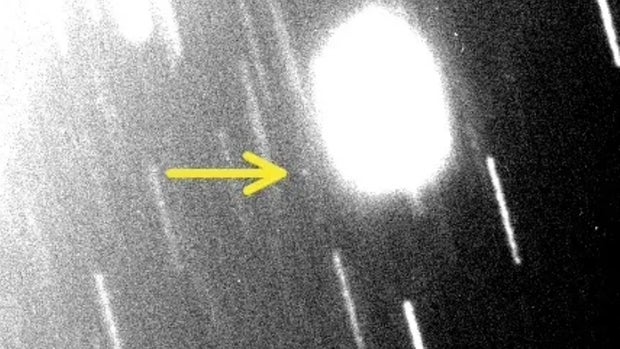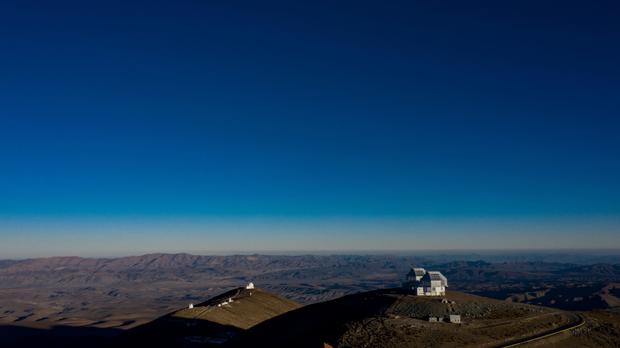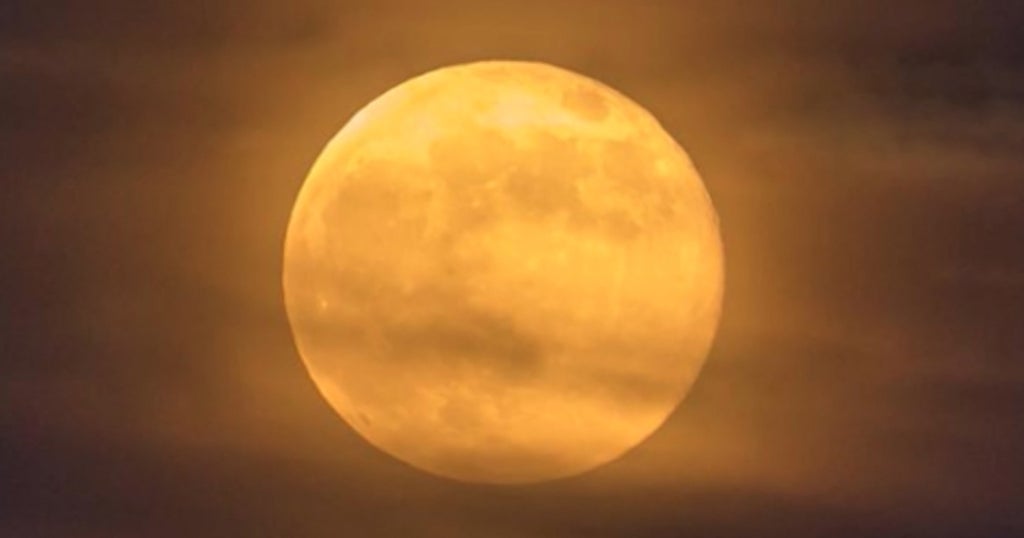CBS News
Astronomers discover 3 tiny moons orbiting Uranus and Neptune

Astronomers with the International Astronomical Union have discovered three previously unknown moons at the farthest planets of our solar system — two circling Neptune and one around Uranus.
The moons were spotted using powerful land-based telescopes at various sites the world. The latest discovery put Uranus at 28 known moons and Neptune at 16.
One moon orbiting Uranus is so small it only measures five miles in diameter.
“The three newly discovered moons are the faintest ever found around these two ice giant planets using ground-based telescopes,” Scott Sheppard, an astronomer at the Carnegie Institution for Science, said in a statement Friday. “It took special image processing to reveal such faint objects.”
Scott Sheppard/Carnegie Institute for Science
Astronomers hope that the discovery will lead to a better understanding of how these moons were formed, the tumultuous early years of our solar system and the movement of the planets on the system’s outer edges.
Astronomers also hypothesize these new moons were captured by the gravity of Uranus and Neptune either during or shortly after they formed.
How did astronomers find the new moons?
Dozens of long-exposure photographs over multiple nights by some of the world’s largest telescopes allowed astronomers a more detailed observation of Uranus’ and Neptune’s surroundings than had previously been possible.
“Because the moons move in just a few minutes relative to the background stars and galaxies, single long exposures are not ideal for capturing deep images of moving objects,” Sheppard said in the press release. “
By layering these multiple exposures together, stars and galaxies appear with trails behind them, and objects in motion similar to the host planet will be seen as point sources, bringing the moons out from behind the background noise in the images,” Sheppard added.
Sheppard used the Magellan Telescope in Chile to find the brighter of the two Neptunian moons. Collaborating with David Tholen at the University of Hawaii, Chad Trujillo at Northern Arizona University and Patryk Sofia Lykawa at Kindai University in Japan, he found the fainter new Neptunian moon using the Subaru Telescope in Hawaii.
MARTIN BERNETTI/AFP via Getty Images
Both moons were first seen in September 2021.
The brighter of the two Neptune moons is about 23 kilometers (about 14 miles) in size, and takes almost nine years to orbit the ice giant. The “faintest” moon takes around 27 years — the longest known orbital journey by a moon — to complete one revolution, according to Sheppard.
Uranus’ newest moon was first spotted in November 2023, also using the Magellan Telescope. Sheppard made follow-up observations a month later. With collaborators, he was able to locate the moon in older images that he’d taken in 2021 at Magellan, as well as at the Subaru telescope in Hawaii.
The Uranian moon measures about 8 kilometers, or 5 miles, in size, and it takes 680 days to orbit the planet.
What will the newly discovered moons be named?
The latest discovery orbiting Uranus marked the first of its kind in more than 20 years. Provisionally named S/2023 U1, the newly-discovered moon will likely be named after a character in a Shakespeare play, in the tradition of other moons orbiting the planet.
The planet’s five major moons — Miranda, Ariel, Umbriel, Titania, and Oberon — are known as “literary moons,” according to NASA. They are named after Shakespearean characters alongside a few named after characters in the works of Alexander Pope
Neptune is named after the Roman god of the sea. Its largest moon, Triton, was discovered in 1846 by English astronomer William Lassell, 17 days after German astronomer Johann Gottfried Galle discovered the planet.
Both of the planet’s newly-discovered moons — S/2021 N1 and S/2002 N5 — will eventually receive permanent names based on the 50 Nereid sea goddesses in Greek mythology, NASA noted.
But the search for more tiny moons is not over, according to Sheppard. “We suspect that there may be many more smaller moons” yet to be discovered, he told the Associated Press.
CBS News
One year after Oct. 7 attack, the toll on civilians remains high

Watch CBS News
Be the first to know
Get browser notifications for breaking news, live events, and exclusive reporting.
CBS News
Open: This is “Face the Nation with Margaret Brennan,” Oct. 6, 2024

Watch CBS News
Be the first to know
Get browser notifications for breaking news, live events, and exclusive reporting.
CBS News
Kamala Harris will speak with “60 Minutes” tomorrow. Here’s what to know for the interview.

Voters will get the chance to hear from Vice President Kamala Harris on Monday as she presents her case for why she should be president in a “60 Minutes” election special.
For decades, “60 Minutes” has featured both Republican and Democratic nominees for presidents, but this year, former President Donald Trump backed out after previously indicating he would be on the show. Correspondent Scott Pelley, who’d been set to interview Trump, will instead travel to Arizona’s Maricopa County, home to more than 60% of Arizona’s voters and a critical battleground in a key swing state.
One thing is certain about the election; with the U.S. deeply involved in both the wars in Ukraine and the Middle East, whoever wins on Nov. 5 will become a wartime president.
What Harris will discuss
Israel’s war started one year ago after Hamas launched a surprise terror attack and correspondent Bill Whitaker will discuss the ongoing war with Harris.
Harris will also discuss the economy, immigration, her record as vice president and the differences between herself and Trump.
Democratic vice presidential candidate Gov. Tim Walz will also appear.
Whitaker joined the Democratic ticket on the campaign trail this week to gain insight into their platform’s priorities and values, and what the candidates believe voters should know.
Why Trump pulled out of the “60 Minutes” interview
Leading up to the candidate hour, Trump, through campaign spokespeople, was the first candidate to accept the “60 Minutes” request to be interviewed for the special, according to CBS News. It had been agreed that both candidates would receive equal time during the broadcast.
Trump last sat down with 60 Minutes in 2020. He walked out during the interview with Lesley Stahl. Trump referenced the incident on Tuesday night at a Milwaukee press conference when asked about his decision not to participate in the Oct. 7 “60 Minutes” election special.
“Well, right now, I went to – they came to me and would like me to do an interview, but first I want to get an apology, because the last time I did an interview with them, if you remember, they challenged me on the computer,” Trump said. “They said the ‘laptop from hell’ was from Russia, and I said it wasn’t from Russia. It was from Hunter, and I never got an apology, so I’m sort of waiting. I’d love to do ’60 Minutes.’ I do everything.”
The Republican nominee for president emphasized that he felt he was owed an apology from “60 Minutes.”
“Let’s see if they do it. I wouldn’t mind doing 60,” Trump continued. “I’ve done ’60 Minutes’ a lot.”
In a statement on Tuesday, Trump campaign communications director Steven Cheung said that Trump’s team had not agreed to an interview.
“Fake News,” Cheung said in a post on X. “60 Minutes begged for an interview, even after they were caught lying about Hunter Biden’s laptop back in 2020. There were initial discussions, but nothing was ever scheduled or locked in. They also insisted on doing live fact checking, which is unprecedented.”
Previous Trump, Harris appearances on 60 Minutes
Trump previously sat down with “60 Minutes'” Mike Wallace in 1985, Pelley in 2015 and Lesley Stahl twice in 2016, first in July of that year and then again in November of 2016. He also spoke with Stahl again in 2018 and 2020.
Harris previously sat down with Whitaker last year. She also was interviewed by Norah O’Donnell, “CBS Evening News” anchor and “60 Minutes” contributing correspondent, in 2020.











